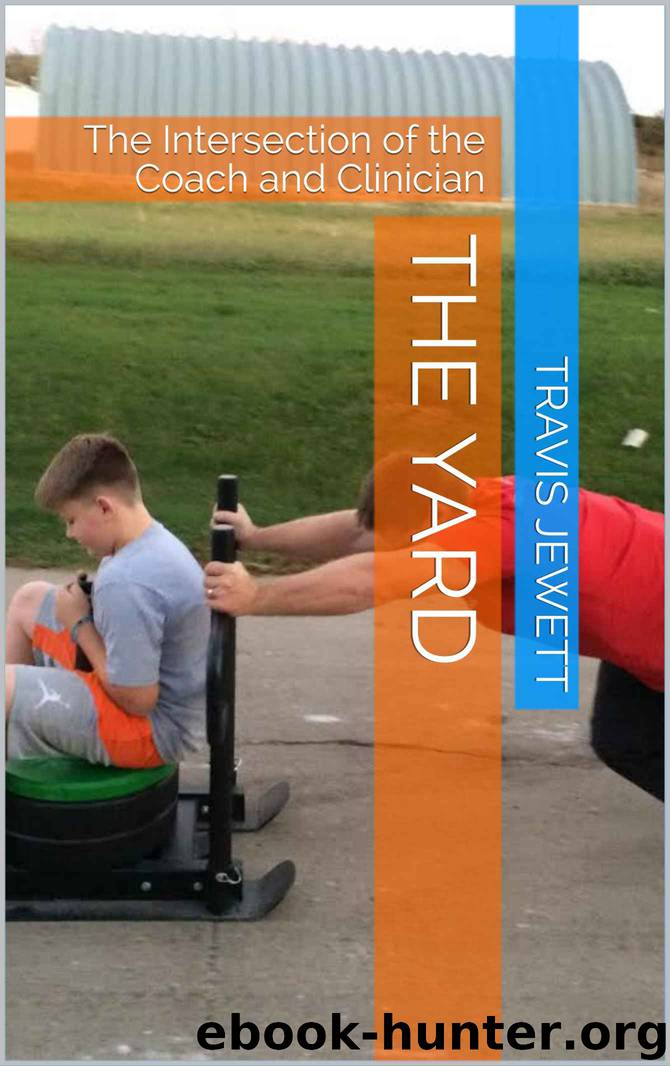The Yard: The Intersection of the Coach and Clinician by Travis Jewett

Author:Travis Jewett [Jewett, Travis]
Language: eng
Format: azw3
Published: 2017-06-07T04:00:00+00:00
Sleds and Carries
Sleds are a very important part of the work done in The Yard. They have also become an integral part of the work I do with patients when I’m wearing my clinician hat. The sled is not just a tool to leave someone face down in your grass convulsing and puking their guts out. While this can easily be done by any moron trainer, there is a greater purpose to sled work. Jim Wendler, who I have the utmost respect for, has said the cure to America’s obesity problem is giving every family a sled. When programmed effectively it is a tremendous low skill conditioning tool with very low chance of injury. It puts people in positions that are typically achievable for even the stiffest and doughiest. There are infinite ways to use it; push it fast with light weight, push it slow with heavy weight, pull it, drag it, row it, hook a rope to it and pull it hand over hand, etc.
We program sled work at least once a week; sometimes twice. For the people who attend The Yard, on the surface, it is about low skill conditioning. If you look at it a little deeper it serves a much more important roll. Sled work is really about bracing and trunk control and creating stiffness. It is about strengthening the body under load while alternating stance. You may have never thought of it that way before.
Louie Simmons, one of the most brilliant coaches of our era and owner of Westside Barbell, has used the sled with his athletes for years. He talks about the conditioning benefits and the way it allows his lifters to get in extra work when they are feeling beat up. Look beyond that and he discusses how great the sled is for lower back strength and development. He credits his original ideas to use the sled to a friend of his from Finland. At that time the Finnish were dominating the world in the deadlift. Turns out most of their champions were guys who did hard manual labor for a living; many of them being lumberjacks. These men would spend all day cutting down trees and dragging sleds of lumber out of the woods. Afterwards they would head off to train. Louie hypothesized the constant low skill work of dragging heavy weights was helping to strengthen their backs and glutes. If you know anything about high level deadlifting, the lower back is typically the weak link. These guys were pull tremendous amounts given their size and rarely dealt with back injuries. This is not far off from the truth. I have done enough sled work and used it with enough people to start drawing some conclusions.
First, there are a few coaches in the powerlifting industry who look down on sled work. Unfortunately they are only looking at it through the lens of conditioning. They argue it lacks specificity to the objective of powerlifting which is a maximum effort in the squat, bench, and deadlift.
Download
This site does not store any files on its server. We only index and link to content provided by other sites. Please contact the content providers to delete copyright contents if any and email us, we'll remove relevant links or contents immediately.
Tools of Titans by Timothy Ferriss(7815)
Bodyweight Strength Training by Jay Cardiello(7676)
Born to Run: by Christopher McDougall(6895)
Inner Engineering: A Yogi's Guide to Joy by Sadhguru(6441)
Asking the Right Questions: A Guide to Critical Thinking by M. Neil Browne & Stuart M. Keeley(5357)
The Fat Loss Plan by Joe Wicks(4622)
Bodyweight Strength Training Anatomy by Bret Contreras(4472)
Yoga Anatomy by Kaminoff Leslie(4103)
Science and Development of Muscle Hypertrophy by Brad Schoenfeld(3971)
Dynamic Alignment Through Imagery by Eric Franklin(3920)
ACSM's Complete Guide to Fitness & Health by ACSM(3824)
The Four-Pack Revolution by Chael Sonnen & Ryan Parsons(3795)
Exercise Technique Manual for Resistance Training by National Strength & Conditioning Association(3788)
Bodyweight Strength Training: 12 Weeks to Build Muscle and Burn Fat by Jay Cardiello(3781)
Yoga Anatomy by Leslie Kaminoff & Amy Matthews(3740)
The Ultimate Bodybuilding Cookbook by Kendall Lou Schmidt(3708)
Yoga Therapy by Mark Stephens(3574)
Nutrition for Sport, Exercise, and Health by Spano Marie & Kruskall Laura & Thomas D. Travis(3556)
Nutrition for Sport, Exercise, and Health by Marie Spano & Laura Kruskall & D. Travis Thomas(3548)
